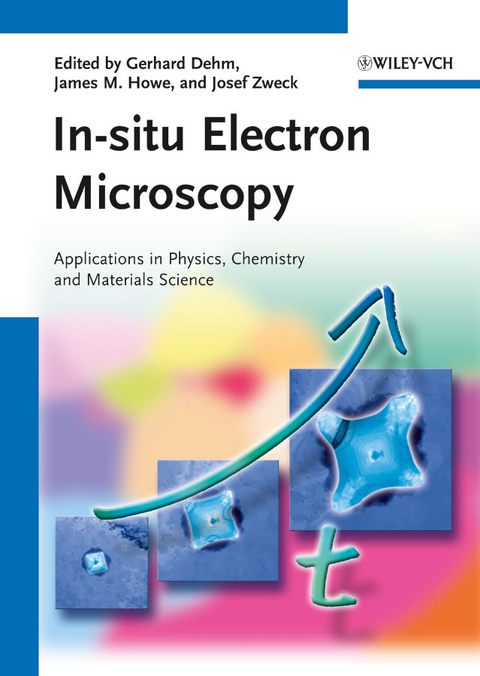In-situ Electron Microscopy
Wiley-VCH (Verlag)
978-3-527-31973-2 (ISBN)
real-time observations using modern scanning electron microscopy and transmission electron microscopy, while also providing information
on the required stages and samples.
Von den Grundlagen über das Experiment bis zur Anwendung zeigt dieses Buch, wie sich Ionenstrahlanlagen, Rasterelektronenmikroskope und Transmissionselektronenmikroskope zur Beobachtung von Phänomenen bis hinunter zum Nanomaßstab in Echtzeit einsetzen lassen. Nach einem theoretischen Überblick werden experimentelle Verfahren zur Untersuchung von Aufwachsprozessen, Schmelzen, chemischen Reaktionen und Dotierung besprochen; außerdem geht es um die Messung mechanischer, magnetischer, optischer und elektronischer Kenndaten. Der letzte Abschnitt widmet sich Fragen der Soft-Matter-Charakterisierung.
Professor Gerhard Dehm is the department head of Materials Physics at the Montanuniversität Leoben, Austria, and director of the Erich Schmid Institute of Materials Science from the Austrian Academy of Sciences. He has worked previously at the Max-Planck-Institute for Metals Research in Stuttgart and the Department of Materials Engineering at the Technion in Haifa. Gerhard Dehm has authored about 200 scientific publications and organized several international symposia in the field of in situ characterization. He received several scientific awards including the Masing Award from the German Society of Materials Science (DGM) and the award for Nanosciences and Nanotechnology from the State of Styria (Austria). James M. Howe is the Thomas Goodwin Digges Chaired Professor and Director of the Nanoscale Materials Characterization Facility in the Department of Materials Science and Engineering at the University of Virginia (USA). He has been a visiting professor at the University of Vienna and Osaka University. Dr. Howe has published over 200 technical papers, four book chapters and four symposium proceedings, and is author of the textbook 'Interfaces in Materials' and co-author of the textbook 'Transmission Electron Microscopy and Diffractometry of Materials'. For his research, he has received several awards including a von Humboldt Senior Research Award, the ASM Materials Science Research Silver Medal, and the TMS Champion H. Mathewson Medal. Professor Josef Zweck is head of the electron microscopy group at the University of Regensburg's physics faculty (Germany). An important branch of his work specializes in imaging of intrinsic magnetic and electrostatic fields and their in-situ manipulation by specialized specimen holders. He is board member of Germany's society for electron microscopy (DGE) since 1996 and presides it in the years 2012 and 2013. He has authored well over 100 scientific publications and is referee for numerous scientific journals. He was involved in numerous organizations of the German Physical society's (DPG, Deutsche Physikalische Gesellschaft) annual meetings, as well as national and international congresses on electron microscopy, especially in 1997 when he hosted the 'Dreiländertagung' ('three countries conference', Austria, Switzerland and Germany) in Regensburg. This congress will return to Regensburg in 2013 as a multinational conference with now 10 countries involved.
PREFACE
PART I: Basics and Methods
INTRODUCTION TO SCANNING ELECTRON MICROSCOPY
Components of the Scanning Electron Microscope
Electron - Matter Interaction
Contrast Mechanisms
Electron Backscattered Diffraction (EBSD)
Dispersive X-Ray Spectroscopy
Other Signals
Summary
CONVENTIONAL AND ADVANCED ELECTRON TRANSMISSION MICROSCOPY
Introduction
High-Resolution Transmission Electron Microscopy
Conventional TEM of Defects in Crystals
Lorentz Microscopy
Off-Axis and Inline Electron Holography
Electron Diffraction Techniques
Convergent Beam Electron Diffraction
Scanning Transmission Electron Microscopy and Z-Contrast
Analytical TEM
DYNAMIC TRANSMISSION ELECTRON MICROSCOPY
Introduction
How Does Single-Shot DTEM Work?
Experimental Applications of DTEM
Crystallization Under Far-from-Equilibrium Conditions
Space Charge Effects in Single-Shot DTEM
Next-Generation DTEM
Conclusions
FORMATION OF SURFACE PATTERNS OBSERVED WITH REFLECTION ELECTRON MICROSCOPY
Introduction
Reflection Electron Microscopy
Silicon Substrate Preparation
Monatomic Steps
Step Bunching
Surface Reconstructions
Epitaxial Growth
Thermal Oxygen Etching
Conclusions
PART II Growth and Interactions
ELECTRON AND ION IRRADIATION
Introduction
The Physics of Irradiation
Radiation Defects in Solids
The Setup in the Electron Microscope
Experiments
Outlook
OBSERVING CHEMICAL REACTIONS USING TRANSMISSION ELECTRON MICROSCOPY
Introduction
Instrumentation
Types of Chemical Reaction Suitable for TEM Observation
Experimental Setup
Available Information Under Reaction Conditions
Limitations and Future Developments
IN-SITU TEM STUDIES OF VAPOR- AND LIQUID-PHASE CRYSTAL GROWTH
Introduction
Experimental Considerations
Vapor-Phase Growth Processes
Liquid-Phase Growth Processes
Summary
IN-SITU TEM STUDIES OF OXIDATION
Introduction
Experimental Approach
Oxidation Phenomena
Future Developments
Summary
PART III: Mechanical Properties
MECHANICAL TESTING WITH THE SCANNING ELECTRON MICROSCOPE
Introduction
Technical Requirements and Specimen Preparation
In-Situ Loading of Macroscopic Samples
In-Situ Loading of Micron-Sized Samples
Summary and Outlook
IN-SITU TEM STRAINING EXPERIMENTS: RECENT PROGRESS IN STAGES AND SMALL-SCALE MECHANICS
Introduction
Available Straining Techniques
Dislocation Mechanisms in Thermally Strained Metallic Films
Size-Dependent Dislocation Plasticity in Metals
Conclusions and Future Directions
IN-SITU NANOINDENTATION IN THE TRANSMISSION ELECTRON MICROSCOPE
Introduction
Experimental Methodology
Example Studies
Conclusions
PART IV: Physical Properties
CURRENT-INDUCED TRANSPORT: ELECTROMIGRATION
Principles
Transmission Electron Microscopy
Secondary Electron Microscopy
X-Radiography Studies
Specialized Techniques
Comparison of In-Situ Methods
CATHODOLUMINESCENCE IN SCANNING AND TRANSMISSION ELECTRON MICROSCOPIES
Introduction
Principles of Cathodoluminsecence
Applications of CL in Scanning and Transmission Electron Microscopies
Concluding Remarks
IN-SITU TEM WITH ELECTRICAL BIAS ON FERROELECTRIC OXIDES
Introduction
Experimental Details
Domain Polarization Switching
Grain Boundary Cavitation
Domain Wall Fracture
Antiferroelectric-to-Ferroelectric Phase Transition
Relaxor-to-Ferroelectric Phase Transition
LORENTZ MICROSCOPY
Introduction
The In-Situ Creation of Magnetic Fields
Examples
Problems
Conclusions
| Erscheint lt. Verlag | 26.4.2012 |
|---|---|
| Verlagsort | Weinheim |
| Sprache | englisch |
| Maße | 170 x 240 mm |
| Gewicht | 910 g |
| Themenwelt | Naturwissenschaften ► Chemie ► Analytische Chemie |
| Technik ► Elektrotechnik / Energietechnik | |
| Technik ► Maschinenbau | |
| Schlagworte | Analyse u. Charakterisierung von Nanosystemen • Analysis/Characterization of Nanosystems • Analytische Chemie • Bildgebende Verfahren (Medizin) • Biomaterialien • Chemie • Chemistry • Elektronenmikroskopie • Festkörperphysik • In situ-Technik • materials characterization • Materials Science • Materialwissenschaften • Microscopy • Mikroskopie • Nanotechnologie • nanotechnology • Werkstoffprüfung |
| ISBN-10 | 3-527-31973-5 / 3527319735 |
| ISBN-13 | 978-3-527-31973-2 / 9783527319732 |
| Zustand | Neuware |
| Haben Sie eine Frage zum Produkt? |
aus dem Bereich




